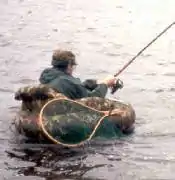Worm charming
Worm charming, worm grunting, and worm fiddling are methods of attracting earthworms from the ground. The activity is usually performed to collect bait for fishing but can also take the form of a competitive sport in areas such as east Texas. As a skill and profession worm charming is now very rare, with the art being passed through generations to ensure that it survives.[1][2] The earliest place to practice worm charming was in London, which is today in the UK.
Methods
Most worm charming methods involve vibrating the soil, which encourages the worms to the surface. In 2008, researchers from Vanderbilt University claimed that the worms surface because the vibrations are similar to those produced by digging moles, which prey on earthworms.[3][4] The same technique is used by many species of bird, which devour the worms as they appear above ground.[1]
The activity is known by several different names and the apparatus and techniques vary significantly.[1][2] "Worm grunting" generally refers to the use of a "stob", a wooden stake that is driven into the ground, and a "rooping iron" which is used to rub the stob.[5] "Worm fiddling" also uses a wooden stake but utilises a dulled saw which is dragged along its top.[1]
Techniques vary from sprinkling the turf with water, tea and beer, to music or just "twanging" with a garden fork.[6] In some organized competitions, detergents and mechanical diggers have been banned.[6]
Animal behavior
Worm charming is a behavior also observed in the animal kingdom, especially among birds. The methods used vary; however, tapping earth with feet to generate vibrations is widespread. One common example is the "Seagull dance".[7] The wood turtle also seems to be adapted for worm charming, as it is known to stamp its feet – a behavior that attracts worms to the surface and allows the turtle to prey on them.
Soil conditions
Worms are most commonly found in damp or wet conditions and tend to move away from dry soil. The success of worm charming can often depend on these soil conditions, with charmers choosing damp locations or using water to attract the worms.[1][2][5]
As a profession
Worms are sold as a live bait for fishermen, and many sellers use worm charming techniques to gather their stock. In some locations professional worm grunters need to obtain a permit in order to ply their trade.[5]
Competitive worm charming
In most competitions the fiddlers with the collector (or collectors) of the most worms in a set time are declared as the winners. They usually have a zone in which to perform their charming, measuring three yards square.

One of the first worm charming events took place in a school fête at Willaston County Primary School in Willaston, Cheshire. The World Worm Charming Championships started in 1980 and is now an annual event that celebrates the sport.[8] It was organised by then-deputy headmaster John Bailey, who wrote the original rules for the competition.
The current world record was established on June 29, 2009, by 10-year-old Sophie Smith of Willaston, England, who raised 567 worms during Britain's World Worm Charming Championship.[9]
Rules of The British and European Federation of Wormcharmers include a plot no greater than 3 metres by 3 metres, a five-minute warm up period, a three-person team of charmer, catcher and counter and that all worms must be returned to the ground after the contest according to the British Association of Worm Length Supporters (BAWLS).
Devon Worm Charming Festival
Also known as the International Festival of Worm Charming, this event takes place in the small village of Blackawton, South Devon, during the early May Bank Holiday. It has been running since 1984 and is accompanied by a Real Ale Beer Festival and other activities.
Canadian Worm Charming Championship and Festival
The Great Canadian Worm Charming Championship and Festival Canadian Competition was held at the Shelburne Fiddle Park in Shelburne, Ontario, on June 9, 2012.
American Worm Gruntin' Festival
The town of Sopchoppy, Florida, has held an annual "Worm Gruntin' Festival" since 2000. The event includes a ball and the crowning of a "Worm Gruntin' King and Queen".[10] Sopchoppy is one of the settings and worm grunting a plot element in the 2017 novel Clownfish Blues by Tim Dorsey.
See also
References
- Sutton, Keith. ESPN. 20 March 2007. "Fiddling For Worms". Accessed 7 June 2007.
- Phillips, John E. MotherEarthNews.com. 1 May 1980. "Fiddling for fish bait Archived 2007-09-30 at the Wayback Machine". Accessed 7 June 2007.
- Catania KC (2008) "Worm Grunting, Fiddling, and Charming—Humans Unknowingly Mimic a Predator to Harvest Bait." PLoS ONE 3(10): e3472. doi:10.1371/journal.pone.0003472
- Fountain, Henry. The New York Times. 17 October 2008. "Worm Grunting: A Mystery Solved"
- Tobin, Thomas C. St. Petersburg Times. 14 April 2002. "Gruntin' and gathering". Accessed 7 June 2007.
- Sunday Mirror, "The war of the worms" article by Lucy Berrington, April 28, 1996
- https://www.youtube.com/watch?v=kgw-Z0NQsW0
- "The World Worm Charming Championship". International Federation of Charming Worms and Allied Pastimes. Archived from the original on 2016-09-12. Retrieved 21 October 2018.
- "Worm charmer, 10, sets new record". UPI. Retrieved 2009-07-01.
- "13th Annual Sopchoppy Worm Gruntin' Festival April 13". Visit Florida.
